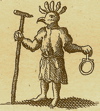 In these lazy days of August, I'm revisiting some of our more popular posts from previous years, here our entry for July 18, 2007:
In these lazy days of August, I'm revisiting some of our more popular posts from previous years, here our entry for July 18, 2007:Dada and Surrealism were still years away when Johann Dieter Wassmann struck out with this monumental, if misunderstood, work, “Of the Stealing of Women” 1896. Never before published or exhibited, the work merges an early 18th century English case-law text, open to a page describing the (limited) rights of women from being, yes, that’s right, stolen, with a medical engraving of mid-19th century bandaging practices, all linked by a harmony of violin pegs and tailpiece. In his notes on the work, Johann enthusiastically describes the piece in terms that we now might read as empowerment and liberation, closing with an enigmatic quote from his beloved muse, Goethe: ‘Man sieht nur, was man weiss.’ One sees only what one knows. Some critics have hesitated at themes they (mis)read as bondage and repression, with one Australian curator going so far as to have the work removed from the exhibition BLEEDING NAPOLEON at the 2003 Melbourne International Arts Festival.
Personally, I believe the work can be read as a nod to the rising sentiment across Europe in support of women's suffrage. Three years earlier, in 1893, New Zealand was the first country to introduce universal suffrage, generating headlines world-wide. The use of an English case-law book would suggest some reference to the British empire here. The image of a woman bandaged suggests a play on the word suffrage. Violin pegs are, of course, necessary to tune the instrument, implying an adjustment or refinement of the social politic to enhance the role of women in 19th century society.
Whatever its inner meaning, the work stands as a significant precursor to the explosive power Dada and Surrealism would have on the course of 20th century modernism.

No comments:
Post a Comment